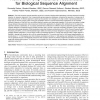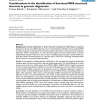10 search results - page 2 / 2 » A Grammar-Based Unification of Several Alignment and Folding... |
TC
2010
13 years 7 months ago
2010
—The most pervasive compute operation carried out in almost all bioinformatics applications is pairwise sequence homology detection (or sequence alignment). Due to exponentially ...
ISMB
1997
13 years 10 months ago
1997
The structural comparison of proteins has become increasingly important as a means to identify protein motifs and fold families. In this paper we present a new algorithm for the c...
CSB
2004
IEEE
14 years 9 days ago
2004
IEEE
Motivation: Since the whole genome sequences for many species are currently available, computational predictions of RNA secondary structures and computational identifications of t...
BMCBI
2007
13 years 8 months ago
2007
Background: Accurate identification of novel, functional noncoding (nc) RNA features in genome sequence has proven more difficult than for exons. Current algorithms identify and s...
BMCBI
2004
13 years 8 months ago
2004
Background: Hidden Markov Models (HMMs) have proven very useful in computational biology for such applications as sequence pattern matching, gene-finding, and structure prediction...


